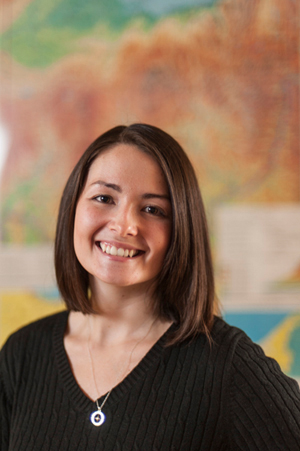By Jennifer Doyle
As someone who spent her childhood sailing the coast of Lake County, Geography graduate student Jessica Kelley is very familiar with Lake Erie’s knack for serving up a good gust of wind. But upon viewing Lincoln Electric’s installation of a massive wind turbine near the shoreline of Euclid, Ohio, she still couldn’t help but wonder why the company had located it there.
Kelley’s master’s thesis aims to answer that question with a model and methodology for determining optimal placement of wind turbines. If it works, she is hopeful that professionals in the renewable energy field can use the tool, as there currently is no systematic method of making such decisions.
Kelley plans to take a variety of different factors such as population density, industrial development, and migratory bird flight patterns and assign them various weightings. She will then collect data for each factor, enter it into a computer program called ArcGIS, and run an analysis on the data.
“The program should spit the results right out onto the map,” Kelley says.
Once she gets those initial results, Kelley will take them to the zoning directors and city planners of the nine different Lake County municipalities included in her study—Willowick, Eastlake, Mentor-on-the-Lake, Mentor, Grand River, Fairport Harbor, Painesville, North Perry, and Madison. Because she will tailor the weightings to the needs and priorities of each city, based on rankings provided by the city officials, she hopes that city planners will be more inclined to use the model.
“It offers a unique perspective, and it begins to extend the use of geographic information systems into a very new and exciting area,” says Dr. James K. Lein, Professor of Geography and Kelley’s academic adviser, about the project concept.
One of Kelley’s biggest challenges has been finding data sets that are relevant and in the format required by the computer system. She is also aware of a different type of challenge-the so-called “N.I.M.B.Y.” (‘not in my backyard’) reaction. She acknowledges that not everyone welcomes the proliferation of wind turbines in Lake County.
“I don’t see that side of it, but I know that it’s there. When I see a wind turbine, I see this wonderful piece of technology, years of engineering refinement that have gone into making this possible,” she says. “Other people can see this scary, giant fan in the sky.”
Kelley expressed frustration with those whose primary concerns are the aesthetic effects of turbine installations. She points out that our need for sustainable energy is too great to dismiss wind power. She also argues that there are plenty of areas that have “low scenic value” where installing turbines won’t be perceived as an intrusion on the horizon.
“I think that we should appreciate what the wind turbine is doing for us, the future of our world, and generations to come,” she says.
Kelley and Lein are in the Department of Geography in the College of Arts and Sciences.
This story appears in the special graduate student edition of Ohio University’s Perspectives magazine, published in spring 2013.


















Comments